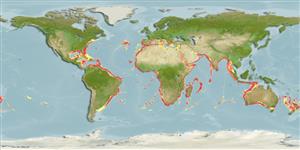Common names from other countries
Elasmobranchii (Haie und Rochen) (sharks and rays) >
Squaliformes (Sleeper and dogfish sharks) >
Centrophoridae (Gulper sharks)
Etymology: Centrophorus: centr[um] (L.), prickle or sharp point; phorus, from phoreus (Gr.), bearer or carrier, referring to grooved spines on dorsal fins. (See ETYFish); uyato: uyat or uyato, derived from agullats or ahullats, vernacular for dogfish sharks in the Mediterranean, based on a Mediterranean Squalus (Squalidae), now applied to this gulper shark from the eastern Indian Ocean and north Atlantic. (See ETYFish).
More on author: Rafinesque.
Issue
Discussion on generic placement in Ref. 27638.
Environment: milieu / climate zone / depth range / distribution range
Ökologie
seewasser bathydemersal; tiefenbereich 50 - 1400 m (Ref. 247), usually 200 - ? m (Ref. 247). Deep-water; 43°N - 43°S
Western Central Atlantic: Gulf of Mexico. Eastern Atlantic: western Mediterranean and Gibraltar to Senegal, Côte d'Ivoire to Nigeria, Cameroon to Angola, northern Namibia. Indian Ocean: southern Mozambique, uncertain records from India; Western Australia (Ref. 6871). Western Pacific: Australia (Ref. 6871); occurrence in Taiwan needs validation. Validity of this species is uncertain (Ref. 27638, not in Ref. 35766).
Length at first maturity / Size / Gewicht / Alter
Maturity: Lm 82.0, range 75 - 89 cm
Max length : 110 cm TL Männchen/unbestimmt; (Ref. 27000); max. veröff. Gewicht: 7.3 kg (Ref. 40637)
Rückenflossenstacheln (insgesamt) : 2; Afterflossenstacheln: 0. A small, slender gulper shark with a long, narrow snout, a short 1st dorsal fin and a high 2nd dorsal fin; pectoral rear tips usually very long; denticles small and flat (Ref. 5578). Brownish-grey above, light grey below (Ref. 5578).
A common deepwater dogfish of the outer continental shelves and upper slopes, on or near the bottom. Adults feed on bony fishes and squid. Males mature by 80 cm TL (Ref. 94782). Ovoviviparous (Ref. 50449). Utilized dried salted for human consumption and probably for fishmeal and liver oil (Ref. 247).
Ovoviviparous, embryos feed solely on yolk (Ref. 50449). Number of young usually only 1. Size at birth between 40 and 50 cm (Ref. 247). Distinct pairing with embrace (Ref. 205).
White, W.T., D.A. Ebert and L.J.V. Compagno, 2008. Description of two new species of gulper sharks, genus Centrophorus (Chondrichthyes: Squaliformes: Centrophoridae) from Australia. pp. 1-21. In P.R. Last, W.T. White and J.J. Pogonoski (eds). Descriptions of new Australian chondrichthyans. CSIRO Marine and Atmospheric Research Paper no. 22. 365 p. (Ref. 76933)
IUCN Rote Liste Status (Ref. 130435)
CITES (Ref. 128078)
Not Evaluated
Bedrohung für Menschen
Harmless
Nutzung durch Menschen
Fischereien: weniger kommerziell
Tools
Zusatzinformationen
Download XML
Internet Quellen
Estimates based on models
Preferred temperature (Ref.
115969): 7.3 - 16.7, mean 11.6 (based on 823 cells).
Phylogenetic diversity index (Ref.
82804): PD
50 = 0.5001 [Uniqueness, from 0.5 = low to 2.0 = high].
Bayesian length-weight: a=0.00251 (0.00161 - 0.00393), b=3.17 (3.04 - 3.30), in cm Total Length, based on LWR estimates for this species & (Sub)family-body (Ref.
93245).
Trophic level (Ref.
69278): 4.5 ±0.60 se; based on food items.
Widerstandsfähigkeit (Ref.
120179): sehr niedrig, Verdopplung der Population dauert mehr als 14 Jahre. (Fec=1).
Fishing Vulnerability (Ref.
59153): High to very high vulnerability (66 of 100).
